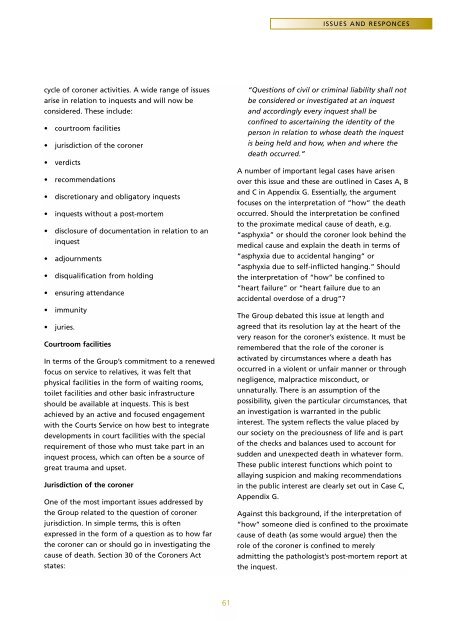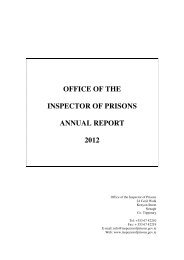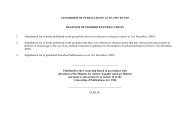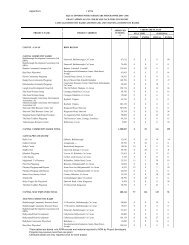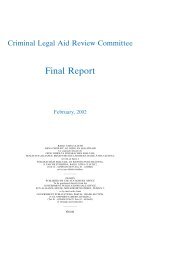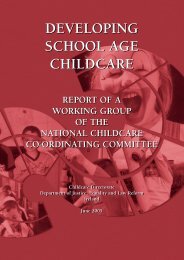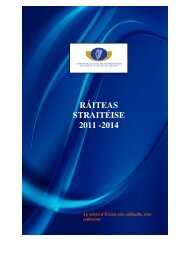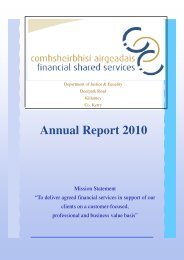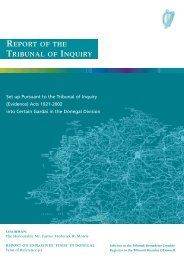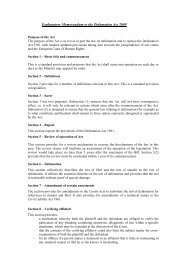ISSUES AND RESPONCEScycle <strong>of</strong> coroner activities. A wide range <strong>of</strong> issuesarise in relation to inquests <strong>and</strong> will now beconsidered. <strong>The</strong>se include:• courtroom facilities• jurisdiction <strong>of</strong> <strong>the</strong> coroner• verdicts• recommendations• discretionary <strong>and</strong> obligatory inquests• inquests without a post-mortem• disclosure <strong>of</strong> documentation in relation to aninquest• adjournments• disqualification from holding• ensuring attendance• immunity• juries.Courtroom facilitiesIn terms <strong>of</strong> <strong>the</strong> Group’s commitment to a renewedfocus on service to relatives, it was felt thatphysical facilities in <strong>the</strong> form <strong>of</strong> waiting rooms,toilet facilities <strong>and</strong> o<strong>the</strong>r basic infrastructureshould be available at inquests. This is bestachieved by an active <strong>and</strong> focused engagementwith <strong>the</strong> Courts <strong>Service</strong> on how best to integratedevelopments in court facilities with <strong>the</strong> specialrequirement <strong>of</strong> those who must take part in aninquest process, which can <strong>of</strong>ten be a source <strong>of</strong>great trauma <strong>and</strong> upset.Jurisdiction <strong>of</strong> <strong>the</strong> coronerOne <strong>of</strong> <strong>the</strong> most important issues addressed by<strong>the</strong> Group related to <strong>the</strong> question <strong>of</strong> coronerjurisdiction. In simple terms, this is <strong>of</strong>tenexpressed in <strong>the</strong> form <strong>of</strong> a question as to how far<strong>the</strong> coroner can or should go in investigating <strong>the</strong>cause <strong>of</strong> death. Section 30 <strong>of</strong> <strong>the</strong> <strong>Coroner</strong>s Actstates:“Questions <strong>of</strong> civil or criminal liability shall notbe considered or investigated at an inquest<strong>and</strong> accordingly every inquest shall beconfined to ascertaining <strong>the</strong> identity <strong>of</strong> <strong>the</strong>person in relation to whose death <strong>the</strong> inquestis being held <strong>and</strong> how, when <strong>and</strong> where <strong>the</strong>death occurred.”A number <strong>of</strong> important legal cases have arisenover this issue <strong>and</strong> <strong>the</strong>se are outlined in Cases A, B<strong>and</strong> C in Appendix G. Essentially, <strong>the</strong> argumentfocuses on <strong>the</strong> interpretation <strong>of</strong> “how” <strong>the</strong> deathoccurred. Should <strong>the</strong> interpretation be confinedto <strong>the</strong> proximate medical cause <strong>of</strong> death, e.g.“asphyxia” or should <strong>the</strong> coroner look behind <strong>the</strong>medical cause <strong>and</strong> explain <strong>the</strong> death in terms <strong>of</strong>“asphyxia due to accidental hanging” or“asphyxia due to self-inflicted hanging.” Should<strong>the</strong> interpretation <strong>of</strong> “how” be confined to“heart failure” or “heart failure due to anaccidental overdose <strong>of</strong> a drug”?<strong>The</strong> Group debated this issue at length <strong>and</strong>agreed that its resolution lay at <strong>the</strong> heart <strong>of</strong> <strong>the</strong>very reason for <strong>the</strong> coroner’s existence. It must beremembered that <strong>the</strong> role <strong>of</strong> <strong>the</strong> coroner isactivated by circumstances where a death hasoccurred in a violent or unfair manner or throughnegligence, malpractice misconduct, orunnaturally. <strong>The</strong>re is an assumption <strong>of</strong> <strong>the</strong>possibility, given <strong>the</strong> particular circumstances, thatan investigation is warranted in <strong>the</strong> publicinterest. <strong>The</strong> system reflects <strong>the</strong> value placed byour society on <strong>the</strong> preciousness <strong>of</strong> life <strong>and</strong> is part<strong>of</strong> <strong>the</strong> checks <strong>and</strong> balances used to account forsudden <strong>and</strong> unexpected death in whatever form.<strong>The</strong>se public interest functions which point toallaying suspicion <strong>and</strong> making recommendationsin <strong>the</strong> public interest are clearly set out in Case C,Appendix G.Against this background, if <strong>the</strong> interpretation <strong>of</strong>“how” someone died is confined to <strong>the</strong> proximatecause <strong>of</strong> death (as some would argue) <strong>the</strong>n <strong>the</strong>role <strong>of</strong> <strong>the</strong> coroner is confined to merelyadmitting <strong>the</strong> pathologist’s post-mortem report at<strong>the</strong> inquest.61
ISSUES AND RESPONCESSince <strong>the</strong> coroner is disallowed from establishingcriminal or civil liability, it has to be said that<strong>the</strong>re are some dangers in prolonging orextending <strong>the</strong> brief in relation to establishing <strong>the</strong>cause <strong>of</strong> death. <strong>The</strong>re is a balance neededbetween <strong>the</strong> continuum where at one extreme, acoroner may only register <strong>the</strong> proximate medicalcause <strong>of</strong> death <strong>and</strong> at <strong>the</strong> o<strong>the</strong>r, carries out whatamounts to a full judicial investigation as ifliability were to be determined. In securing thatbalance, <strong>the</strong> Group are unanimous in <strong>the</strong>ir viewthat it is not appropriate to confine <strong>the</strong>investigation to <strong>the</strong> proximate medical cause <strong>of</strong>death as some interpretation <strong>of</strong> <strong>the</strong> legislationhas indicated (see Cases A <strong>and</strong> B, Appendix G).This view does not, <strong>the</strong> Group believes, take intosufficient account <strong>the</strong> core reason for having acoroner system in <strong>the</strong> first place. <strong>Coroner</strong>jurisdiction should extend not only to establishing<strong>the</strong> medical cause <strong>of</strong> death but also toinvestigating <strong>the</strong> surrounding circumstances <strong>of</strong>death. <strong>The</strong> Group also felt that unlike <strong>the</strong> presentwording in <strong>the</strong> Act, <strong>the</strong> duties <strong>and</strong> powers <strong>of</strong> acoroner at an inquest should be stated in positiveterms along <strong>the</strong> following lines:<strong>The</strong> inquest has a duty to establish <strong>the</strong>following: <strong>the</strong> identity <strong>of</strong> <strong>the</strong> deceased, when<strong>and</strong> where <strong>the</strong> death took place, <strong>the</strong> medicalcause <strong>of</strong> death <strong>and</strong> <strong>the</strong> surroundingcircumstances <strong>of</strong> death: in establishing this, <strong>the</strong>coroner is not permitted to allow anyconsideration <strong>of</strong> <strong>the</strong>se matters whichapportions civil or criminal liability.Verdicts<strong>The</strong> uncertainty about <strong>the</strong> jurisdiction <strong>of</strong> <strong>the</strong>coroner has, in turn, led to considerable confusionover <strong>the</strong> verdicts which can be returned atinquest. If <strong>the</strong> coroner must be confined to <strong>the</strong>proximate cause <strong>of</strong> death, verdicts such as suicideare problematic in that <strong>the</strong>y can be considered togo beyond <strong>the</strong> proximate cause <strong>of</strong> death. Clarityabout jurisdiction will go a long way towardsresolving <strong>the</strong> verdicts issue but a number <strong>of</strong> pointsneed to be discussed in relation to <strong>the</strong> generalquestion <strong>of</strong> verdicts.<strong>The</strong> suicide verdict<strong>The</strong>re was general agreement in <strong>the</strong> Group that ifit was proved beyond reasonable doubt that aperson took <strong>the</strong>ir own life, <strong>the</strong>n a verdict <strong>of</strong>suicide should be recorded. Suicide verdicts shouldbe returned as appropriate <strong>and</strong> <strong>the</strong> Group believethat this is in <strong>the</strong> interests <strong>of</strong> society generally,including relatives. Of paramount importance,however, was <strong>the</strong> sensitive h<strong>and</strong>ling <strong>of</strong> such casesby coroners <strong>and</strong> <strong>the</strong> need for support services todeal with bereaved families.Verdicts in general<strong>The</strong> Group observed a lack <strong>of</strong> consistent criteriafor reaching verdicts <strong>and</strong> suggested thatguidelines in this area be part <strong>of</strong> <strong>the</strong> <strong>Coroner</strong>s’Rules as outlined in Appendix J. <strong>The</strong> generalrelationship between verdicts <strong>and</strong> jurisdictionshould be positively stated along <strong>the</strong> followinglines:<strong>The</strong> verdict reached at inquest shall be <strong>the</strong>findings in relation to <strong>the</strong> matters establishedin accordance with (<strong>the</strong> new section 30 asdetailed in <strong>the</strong> previous paragraph) toge<strong>the</strong>rwith conclusions as to death.Power to make recommendations<strong>The</strong> final point which is linked to <strong>the</strong> question <strong>of</strong>jurisdiction <strong>and</strong> verdicts relates to <strong>the</strong> power <strong>of</strong><strong>the</strong> coroner to make “recommendations <strong>of</strong> ageneral character designed to prevent fur<strong>the</strong>rfatalities”. <strong>The</strong> Group felt that this function wasconsistent with <strong>the</strong> view <strong>of</strong> <strong>the</strong> coroner functiontaken by <strong>the</strong> Group in relation to <strong>the</strong> publicservice aspect <strong>of</strong> coroner work <strong>and</strong> should becontinued in new legislation. It was noted that<strong>the</strong> coroner or jury only has <strong>the</strong> power to make“recommendations”. While every effort should bemade by o<strong>the</strong>r relevant authorities to follow upon such recommendations, <strong>the</strong> Group did notconsider it appropriate to extend <strong>the</strong> strength <strong>of</strong><strong>the</strong> coroner’s input in this area. <strong>The</strong> proposed<strong>Coroner</strong> Agency could, it was felt, take aparticular interest in ensuring that coronerrecommendations were, in fact, appropriately62


